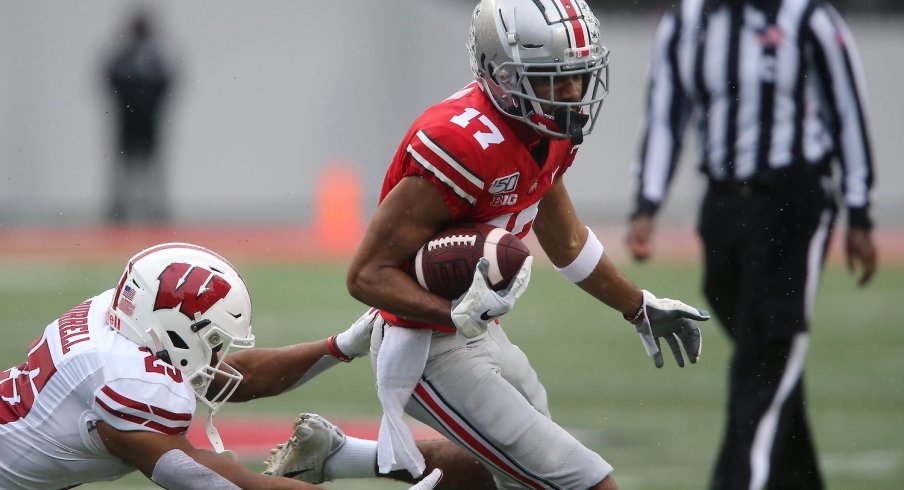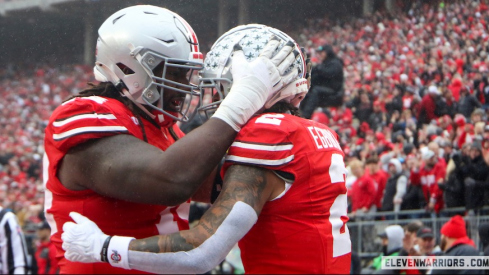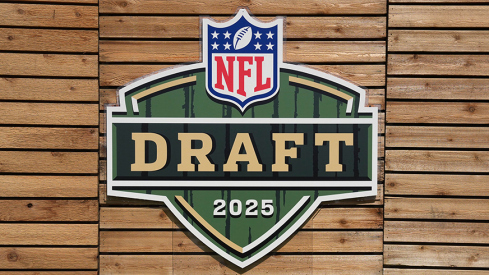Eight games down, seven more to go?
With Ohio State's second bye week of the year coming this weekend, there is no better time than now to kick back and reflect on the Buckeyes' outstanding offensive success.
Creating highlight lists are fun, of course, but let's add another dimension to it. To rank the plays, we will be using expected points added, which assigns a value that determines the effectiveness of each play.
As mentioned in other articles on this site that have referenced expected points added (EPA), the metric is based on the fact that not all yards are created equal. The statistic takes into account the down, distance, field position, possession and more to evaluate each play.
For a more robust explanation, take a look at how ESPN describes EPA:
The value it puts out is on a scale from about minus-3 to 7, and it basically represents "which team is likely to score next, and how many points?" It represents the likely points not just on the current drive but also on the next drive or any subsequent drive until the score changes or the half ends. A lower value indicates a more favorable situation for the defense (i.e. fourth-and-20 from your own 1-yard line could be close to minus-3 EP), and a higher value represents a more favorable situation for the offense (i.e. first-and-goal is generally worth 6 EP).
Without going into technical details, the key is that the relationships in the EP formula encapsulate the basic tenets of football, including:
• Being closer to the opposing goal line and farther from your own is better
• Earlier downs are better (first-and-10 is better than second-and-10, etc.)
• Shorter distance to go is better
It is important to note that while EPA can be used to rank single plays, it can also be used to summarize an entire team's production, find a player's total contribution, and more.
While there is no standard expected points added model for college football like there is in the NFL, it is quite easy to create. Parker Fleming (not the Ohio State quality control coach), a Ph.D. candidate at Southern Methodist University and contributor at TCU's SB Nation site Frogs O' War, did exactly that and developed a live EPA model for college football using play-by-play data.
Using his model, we can take a look at Ohio State's five best offensive plays this season, according to expected points added.
5. Binjimen Victor Takes a Short Pass the Distance Against the Spartans
Binjimen Victor always seems to come through in the biggest moments. While he might not be as consistent as some want, Victor's game-breaking potential is unmatched.
In the second quarter of a close game against Michigan State, the senior wideout once again came through, this time with a 60-yard catch-and-run to put Ohio State up three scores.
Incredible play design, incredible execution. pic.twitter.com/XZMI5qQwnV
— Eleven Warriors (@11W) October 6, 2019
Victor's effortless move to elude the defender and his high-flying dive earned the Buckeyes an estimated 4.95 points, making it the fifth-best offensive play of the season thus far.
It was the second of three second-quarter touchdowns against the Spartans, a game the Buckeyes won 34-10.
4. Olave Catches a Huge 27-Yard Touchdown Against Wisconsin
Ohio State started slow for the first 25 minutes of the game. After Blake Haubeil kicked a 49-yard field goal to give the Bucks a 3-0 lead and another defensive stop, however, the Buckeyes had the opportunity to go up two scores before the break.
After a failed trick play and a Justin Fields sack brought third-and-long, it looked as if the Bucks would be settling for another field goal.
Cue Chris Olave.
TOUCHDOWN, @OhioStateFB!@justnfields @chrisolave_ = 6 pic.twitter.com/S6XmwyFFsq
— Ohio State on BTN (@OhioStateOnBTN) October 26, 2019
The true sophomore was easily Ohio State's best offensive player in the first half against the Badgers, racking up 56 yards on four catches and five targets. Three of Olave's catches were for first downs and his final one, as seen above, was for a touchdown.
The Buckeyes gained an expected 4.97 points from the 27-yard touchdown, making it Ohio State's best offensive play against the Badgers and the fourth-best of the season. Olave ended the 38-7 win with seven catches for 93 yards, two touchdowns, and contributed 15.53 EPA in eight targets, by far the best mark of any Ohio State receiver this season.
3. Binjimen Victor Reels in a 30-yard Touchdown Versus Miami
After Sevyn Banks' blocked punt, Ohio State was sitting pretty with starting field possession in the red zone. After a first-down holding penalty and two incompletions, however, it was suddenly in 3rd-and-20 on the edge of field-goal range.
The resulting throw is arguably the best of Justin Fields' young career.
This ball could not have been thrown more perfectly. My goodness. pic.twitter.com/ii1qaRFbBo
— Eleven Warriors (@11W) September 21, 2019
The 6-foot-4 senior receiver makes his second appearance on this list with yet another impressive catch. Fields and Victor connected here for the best passing play of the season thus far, adding 5.29 expected points for Ohio State.
While EPA is a great statistic, it does not take the strength of the opponent into play. Because of this limit, it might make more sense to rank this play (which was occurring in a game that would end with a final score of 76-5) below the likes of Olave's Wisconsin catch if one was creating a more subjective list.
2. J.K. Dobbins Takes it the Distance Against Cincinnati
The I-71 Showdown, the first iteration of the matchup since 2014, concluded in a resounding victory for the Buckeyes. Ohio State shut out the Bearcats, who are now 7-1 and ranked No. 17, 42-0 after a full-team dominant performance.
Justin Fields totaled four touchdowns, but J.K. Dobbins had the biggest play of the day, bursting through the line for a 60-yard touchdown halfway through the second quarter.
Dobbins and Ohio State are inflicting damage running behind the left side of the OL today. Thayer Munford is having himself a game. pic.twitter.com/dGvmLZMPJY
— Eleven Warriors (@11W) September 7, 2019
Dobbins' score gave the home team a three-score lead, which would be extended to four before the break. The 60-yard dash was good for 5.31 expected points and was, at the time, the longest run of his career.
The junior running back totaled 141 rushing yards and two touchdowns against Cincinnati, a stat line we are becoming more and more accustomed to seeing this year. Through eight games, he is averaging 138.75 rushing yards and 1.38 total touchdowns per contest.
1. J.K. Dobbins Splits Michigan State Apart
This one is just magical.
Up 17-10 in the second quarter, Ohio State was facing a pivotal third-and-short. The Buckeyes needed a first down to extend the lead before halftime.
They got the first and then some.
J.K. Dobbins has some wheels. pic.twitter.com/YdCrJQehbz
— Eleven Warriors (@11W) October 6, 2019
Dobbins' 67-yard touchdown run on third down is Ohio State's best offensive play through eight games, according to EPA. The run added an expected 6.24 points for the Bucks and gave the local team a two-score advantage before the break.
Dobbins, the nation's second-leading rusher with 1,110 yards, is on pace to become Ohio State's second-leading rusher of all time. The junior tailback is also seventh among Power Five running backs in total rushing EPA this year.


